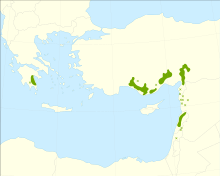-
Foliage
-
Branches in Israel
-
Two views of a cone

Summary
Juniperus drupacea, the Syrian juniper, is a species of juniper native to the eastern Mediterranean region from southern Greece (mount Parnon in the Peloponnese), southern Turkey, western Syria, and Lebanon, growing on rocky sites from 800–1,700 metres (2,600–5,600 feet) in altitude. The species is the sole member of Juniperus sect. Caryocedrus.,[2][3] which is sometimes recognised as genus Arceuthos.[4]
| Juniperus drupacea | |
|---|---|

| |
| Specimen in Madrid, Spain | |
| Scientific classification | |
| Kingdom: | Plantae |
| Clade: | Tracheophytes |
| Clade: | Gymnospermae |
| Division: | Pinophyta |
| Class: | Pinopsida |
| Order: | Cupressales |
| Family: | Cupressaceae |
| Genus: | Juniperus |
| Section: | Juniperus sect. Caryocedrus |
| Species: | J. drupacea
|
| Binomial name | |
| Juniperus drupacea | |

| |
| Natural range | |
Description edit
Juniperus drupacea is the tallest species of juniper, forming a conical tree 10–25 metres (33–82 feet) tall, exceptionally up to 40 m (130 ft), and with a trunk up to 1–2 m (3+1⁄2–6+1⁄2 ft) thick. It has needle-like leaves in whorls of three; the leaves are green, 5–25 millimetres (1⁄4–1 in) long and 2–3 mm broad, with a double white stomatal band (split by a green midrib) on the inner surface. It is usually dioecious, with separate male and female plants.
The seed cones are the largest of any juniper, berry-like but hard and dry, green ripening in about 25 months to dark purple-brown with a pale blue waxy coating; they are ovoid to spherical, 20–27 mm (3⁄4–1 in) long and 20–25 mm diameter, and have six or nine fused scales in 2–3 whorls, each scale with a slightly raised apex. The three apical scales each bear a single seed, but with the three seeds fused together into a single nut-like shell. The male cones are produced in clusters (unlike any other juniper) of 5–20 cones together, yellow, 3–4 mm long, and fall soon after shedding their pollen in early spring.
Taxonomy edit
Because of its distinct cones with the seeds fused three together and the clustered male cones, it has sometimes been treated in a distinct genus of its own as Arceuthos drupacea (Labill.) Antoine & Kotschy, but genetic studies have shown it is fairly closely related to J. macrocarpa and J. oxycedrus.
References edit
- ^ Gardner, M. (2013). "Juniperus drupacea". IUCN Red List of Threatened Species. 2013: e.T30311A2792553. doi:10.2305/IUCN.UK.2013-1.RLTS.T30311A2792553.en. Retrieved 19 November 2021.
- ^ Adams, Robert P. & Schwarzbach, Andrea E. (2013). "Phylogeny of Juniperus using nrDNA and four cpDNA regions" (PDF). Phytologia. 95 (2): 179–187. Retrieved 2022-04-22.
- ^ Uckele, Kathryn A.; Adams, Robert P.; Schwarzbach, Andrea E. & Parchman, Thomas L. (2021). "Genome-wide RAD sequencing resolves the evolutionary history of serrate leaf Juniperus and reveals discordance with chloroplast phylogeny". Molecular Phylogenetics and Evolution. 156: 107022. doi:10.1016/j.ympev.2020.107022. PMID 33242585. S2CID 227182680.
- ^ Yang, Yong; Ferguson, David Kay; Liu, Bing; Mao, Kang-Shan; Gao, Lian-Ming; Zhang, Shou-Zhou; Wan, Tao; Rushforth, Keith; Zhang, Zhi-Xiang (2022). "Recent advances on phylogenomics of gymnosperms and a new classification". Plant Diversity. 44 (4): 340–350. doi:10.1016/j.pld.2022.05.003. PMC 9363647. PMID 35967253.
External links edit
- Arboretum de Villardebelle photos of cones & shoots
- Conifers Around the World: Juniperus drupacea - Syrian Juniper.



